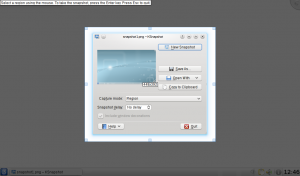Taking Screenshots: Difference between revisions
Appearance
| Line 9: | Line 9: | ||
== Workflow == | == Workflow == | ||
In this example [[KSnapshot|KSnapshot]] is used, but other screen capture applications work as well. | In this example [[KSnapshot|KSnapshot]] is used, but other screen capture applications work as well. | ||
[[Image:Screenshot-ksnapshot.png|center|300px|thumb|Capturing a screenshot of KSnapshot]] | |||
* Open KSnapshot | * Open KSnapshot | ||
Revision as of 10:55, 9 July 2010
Guidelines
- When taking screenshots of single a application/window, use a white background and include a margin (around 20 pixels) of the white wallpaper (this is to ensure that window shadows don't look cropped)
- Set the language to English unless it's a localized screenshot
- Save as PNG image
- Preferably, use the default settings (icons, color scheme, style, window decoration, application settings etc.)
- Preferably, use compositing (see Desktop Effects module in System Settings)
- Preferably, use Liberation Sans, 9pt as font
Workflow
In this example KSnapshot is used, but other screen capture applications work as well.

- Open KSnapshot
- Choose a Capture mode
- Full Screen: Everything on the screen is captured, usually used for desktop screenshots
- Region: Only a region defined by the user is captured, usually used for application screenshots
- Click on New Snapshot
- Full Screen: Click anywhere on the screen to take the snapshot
- Region: Use the mouse to draw a rectangle around the region to be captured (for example around a window). Click on Enter or double click in the region to take the snapshot
- Click on Save As...
- Browse to the location you want to save the image, give it a name (name.png) and click on Save
